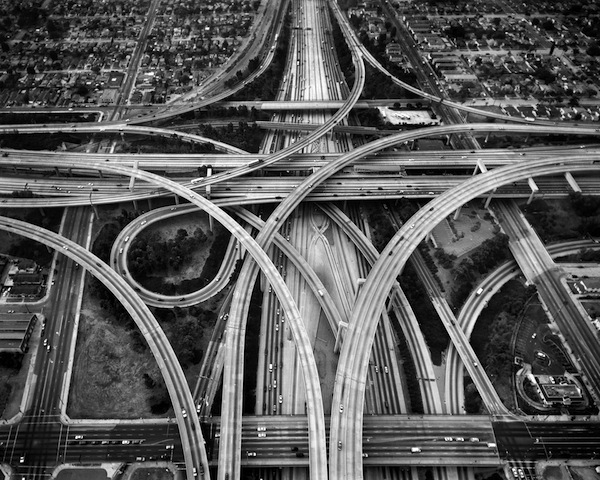Maybe the freeway isn’t a cliché.
The first book I decided to read, or reread, upon becoming a permanent resident of Los Angeles – following three years of cross-country commutes between NYC and LA – was Reyner Banham’s Los Angeles: The Architecture of Four Ecologies (1971). I had conveniently forgotten how Mike Davis, in perhaps one of the best social histories of LA’s particular conurbation, his City of Quartz (1990), dismissed Banham as one of its ‘boosters’, and so rendered Banham’s book kind of off-limits for the self-serious left (or was that the self-conscious left? No matter) – and so I plunged in.
For all its breezy sociology, Banham’s The Architecture of Four Ecologies is great for its diagrammatic simplicity, which is to say for its diagrams, pure and simple. The map of the water grid and late-nineteenth-century railroad lines, which appears in the book’s introductory chapter, ‘In the Rear-view Mirror’, is a picture of inevitability. Here is the structure that gives body to ‘Los Angeles’ as an idea. The freeways, one can see, are byproducts of this earlier steam and water circulation, for which, as the Annales school was learning at the same time, geography would be destiny.
The question of course is: where does it all go? The answer of course is: Hollywood. Banham’s book was published in 1971. The second book I read was Eve Babitz’s Slow Days, Fast Company, which came out in 1977, and was a follow-up of sorts to Eve’s Hollywood (1974), her breakout quasi-tell-all, which I haven’t read, though I know how it begins: with a description of the author’s visual sense. She doesn’t like to see numbers written out, she likes ‘10’ as opposed to ‘ten’, because she’s more ‘artist’ than ‘writer’. That’s pretentious, and it’s meant to be. I suspect the rest of the book is meant as an attempt to make you like her anyway (we’ll see; it’s on deck).
‘She drove the San Diego to the Harbor, the Harbor up to the Hollywood, the Hollywood to the Golden State, the Santa Monica, the Santa Ana, the Pasadena, the Ventura.’
But being an ‘artist’ isn’t a reason. Being from Los Angeles is. Banham’s diagrams offer a clue. Today the freeways are called, for example, simply ‘the 101’, ‘the 10’, ‘the 5’, or ‘the 405’ (or, so I’ve heard, ‘the fucking 405’). Banham’s map has them as ‘the Hollywood freeway’, ‘the Santa Monica freeway’, ‘the Golden State freeway’, and ‘the San Diego freeway’. These characters make appearances in Slow Days. Here’s a typical passage: ‘It takes two hours for an ordinary person to get from Hollywood to Bakersfield, so I planned on three, and got out of the house and onto the Hollywood Freeway by 7:00 a.m.’ Babitz must like the way the numbers look because she sees them flying overhead, where they’re never written out, because reading at 70mph is, presumably, dangerous – though everyone seems to do it. To write them out is to slow down.
‘She drove the San Diego to the Harbor, the Harbor up to the Hollywood, the Hollywood to the Golden State, the Santa Monica, the Santa Ana, the Pasadena, the Ventura.’ This isn’t Babitz, it’s Didion, or rather it’s Maria Wyeth, Joan Didion’s achingly absent main character in Play It As It Lays (1970), which is often written about as a scathing critique of Hollywood’s vapidity and vampire ways. The story of Maria’s unravelling is told in first-person and what Didion calls a ‘close third’. Today it reads like a 1950s closeup: Vaseline-lensed and lacking in fine lines. The narrator is close, but the story isn’t. There is a divide between Didion’s LA (and Babitz’s, and Banham’s) and today, which is registered in the writing, in the style which is disconnected, episodic.
Maria likes to drive. The freeway is ‘the organism which absorbed all her reflexes, all her attention’. Banham liked to drive as well: ‘the actual experience of driving on the freeway prints itself deeply on the conscious mind and unthinking reflexes’. For Didion, the freeway is the book. It’s what’s American in the American novel (in Los Angeles, at least), where movement and migration matters more than plot.
Today that novel is more numerical, more algorithmic. This has nothing to do with the descent of tech culture and tech economies upon the Southern Californian coastline. I’d venture it has more to do with a tightening of the landscape, of the geography. The cars are more numerous and more enclosed (not so many convertibles today). They are quieter. There are screens everywhere. The numbers that are flying overhead have shed their connection to any place one might be going. ‘The San Diego freeway’ doesn’t exist any more, because no one is going to San Diego; they ‘take’ the 405. In a town that once boasted of no nine-to-five jobs, people are just going to work.
This article first appeared in the December 2016 issue of ArtReview
